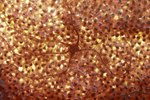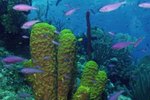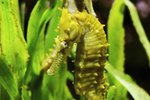
Sea-Monkeys are a trademarked brine shrimp marketed by Harold von Braunhut starting in 1957. His comic-book advertisements depicted personified cartoon "sea monkeys" striking whimsical poses with smiling faces, hands, fins and long tails. Many who ordered them were disappointed when their birthed Sea-Monkeys turned out to be wholly unlike the tiny semi-humans in the ads. Still, Sea-Monkeys became a pop culture phenomenon and remain popular to this day.
Monkeys of the Sea
Brine shrimp are crustaceans in the genus Artemia. Von Braunhut hybridized different species of Artemia to develop the artificial breed Artemia NYOS, or New York Ocean Science. Artemia NYOS, called Sea-Monkeys, grows larger and lives longer than regular brine shrimp. Kits still sell today, in 2012 for $5.95 to $25.95.
Characteristics
When they are born, Sea-Monkeys have one eye. They undergo molting up to seven times throughout their life cycle. Adults have three eyes, 11 pairs of legs and a tail. Sea-Monkeys breathe through their feet. Males have two reproductive organs and two large antennae, while females have a large egg sack on their abdomens and one small antenna. Males are slightly smaller than females. Sea-Monkeys mate when they are between 4 and 6 weeks old. Some have two-year life spans.
Reproduction
Sea-Monkeys reproduce sexually and asexually. Males attach themselves to a female and remain connected for a span of days to weeks. The female develops an egg sack in her abdomen at the base of her tail once the male detaches. The gestation period varies among females, suggesting that females are able to wait for favorable conditions before giving birth. Females can also produce offspring by themselves if no males are present. When females fertilize their own eggs it is called “parthenogenesis.” Litters yield about 20 Sea-Monkeys. As long as water is aerated every day and temperatures are kept at 82 degrees Fahrenheit, offspring reach sexual maturity after 12 days.
Just Add Water
When you get a Sea-Monkey kit, you get several packets containing various items, including salt and dry brine shrimp eggs, yeast and spirulina. The brine shrimp undergo a process called "cryptobiosis," which is a state of suspended animation that allows the Sea-Monkeys to come to life when you add water.
References
- The Amazing Live Sea-Monkeys: Sea Monkeys Rule
- Hobby Science: Sea Monkey Stuff
- Sea Monkey Worship: Interview With Harold Von Braunhut; Creator of Sea Monkeys
- The New York Times: Harold von Braunhut, Seller of Sea Monkeys, Dies at 77
- The Awl: The Shocking True Tale of the Mad Genius Who Invented Sea-Monkeys
Photo Credits
-
Michael Loccisano/Getty Images Entertainment/Getty Images
Writer Bio
Vivian Gomez contributes to Retailing Today, the Daily Puppy, Paw Nation and other websites. She's covered the New York Comic Con for NonProductive since 2009 and writes about everything from responsible pet ownership to comic books to the manner in which smart phones are changing the way people shop. Gomez received her Bachelor of Arts in English literature from Pace University.



